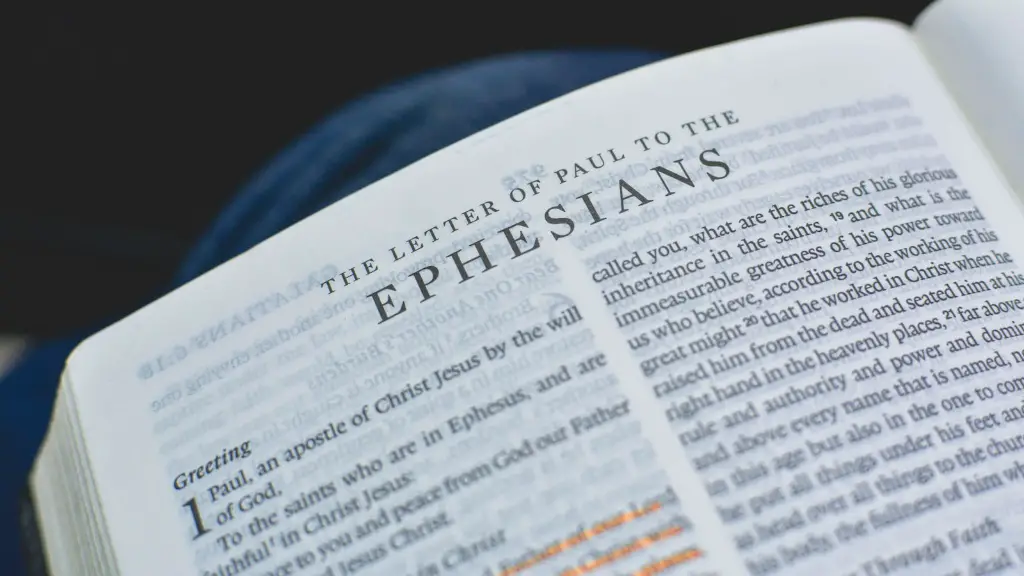As society continues to evolve, conversations about sexuality and lifestyle choices have become increasingly commonplace. One topic that frequently comes up in discussions is whether or not homosexuality is mentioned in the Bible. Many Christians take a strict religious stance on the topic, while others argue that the Bible acknowledges and, in fact, even approves of same-sex relationships.
It may surprise some to know that the Bible fails to reference homosexuality directly. In fact, the word “homosexual” isn’t even mentioned, neither in the Old Testament nor in the New. Although the Bible speaks of sexual behaviour between men and women with a certain amount of specific detail, same-sex behaviour is never explicitly described.
However, there are several passages in both the Old and New Testament that are interpreted by many to be referring to same-sex relationships, explicitly or implicitly. The most common passages cited in this case are from Leviticus 18:22 and 20:13, which state that people should not sleep with people of the same gender. While research shows it is possible for these passages to be interpreted differently, most insist that these verses are speaking directly about same sex relationships.
The debate around this topic often revolves around the religious implications: can one still hold to the teachings of the Bible and be accepting of same sex relationships? Many in the Biblical community are quick to point out that the Bible is a historical document and that its purpose is mainly to share an experience of God’s love and work in the world. As such, the Bible can be interpreted in different ways, depending on the context and view of the reader.
On one hand, some Christians argue that the Bible is clear in its condemnation of same-sex relationships, while others take the view that such relationships should be respected and accepted in the same way that heterosexual relationships are. And there are even different interpretations of how same-sex relationships should be treated—some argue that it should be encouraged, while others may believe it should be respected and not accepted. Despite the wide range of opinions, it’s important to remember that the Bible does not explicitly condemn same-sex relationships.
In the end, the decision of whether or not to accept homosexuality or to embrace same-sex relationships is up to the individual. This is an incredibly complex story, one that is still unfolding. Whatever the outcome, one thing is certain—there is no one-size-fits-all answer to the question of whether homosexuality is in the Bible.
Effects Of Attitudes Towards Homosexuality On Health And Well Being
The attitudes and beliefs towards homosexuality have been a long source of debate for centuries and have been integral in the development of a society’s culture and values. Consequently, attitudes towards homosexual behaviour are a focus of research into its effects on health and well being. Studies from multiple disciplines have found that prejudice and the social stigma faced by homosexuals have the potential to cause physical and mental health issues in them. For example, low-level assumptions that can be found around slurs that have become commonplace language have a long lasting impact on those who identify as LGBT+ and can result in a lower sense of well being.
A recent World Health Organization study has suggested that no single factor is more powerful than stigma and discrimination when affecting an individual’s well being. Homophobia, biphobia and transphobia have been known to limit an individual’s access to mental health services and support, and has been associated with higher rates of self-harm. There has also been a link established between broader societal attitudes to LGBT+ people and the prevalence of HIV in the community, with individuals displaying internalised homophobia more likely to take risks when engaging in sexual activities.
Societal attitudes have been shown to have an influence on the quality of an LGBT+ person’s mental health, with a correlation being established between levels of acceptance and associated mental health issues. The LGBT+ community have also been found to be at an increased risk for substance abuse and for developing eating disorders. The risks of obesity have also been found to be higher for homosexual adults than for heterosexual adults, with the former displaying poorer levels of physical health than the later. This indicates that there is an additional burden placed on the LGBT+ community which can have an influence on their physical and mental health.
Stereotypes and Misconceptions About Homosexuality
Stereotypes and misconceptions about homosexuality are pervasive in many societies. These negative attitudes lead to discrimination and prevent the full acceptance of homosexuality. The most common misconception is that all homosexuals are promiscuous and engage in multiple sexual relationships. This is untrue. All individuals have the right to pursue their own values and their own definition of a successful relationship, regardless of sexual orientation.
Additionally, it is often thought that homosexuality is a mental illness or a character defect. This belief has been disproven by modern science. There is no scientific evidence to support the idea that being homosexual is anything other than a natural part of the human diversity. As such, homosexuality is no longer classified as a disorder by the psychological profession.
Furthermore, homosexuality has been falsely seen as a choice. If a person felt as though, for example, they had a predisposition towards adopting dogs instead of cats, it would not be seen as a decision or behavior to be judged, so why are those who are attracted to the same sex any different? The truth is, sexual orientation is largely determined in the formative years of a person’s life and is not something they necessarily choose.
Finally, there is growing evidence to suggest that gender roles are not necessarily fixed and that individuals maintain a certain degree of flexibility when it comes to expressing their gender. This means there can be more fluid gender roles and sexual orientations, which is contrary to the traditional beliefs that certain roles are fixed and in opposition to the idea that homosexuality is immoral.
The Different Types Of Homosexuality
There are a variety of different types of sexual behavior that could be considered homosexual. For example, there is bisexuality, which is defined as an attraction to both genders, and pansexuality, which is defined as an attraction to any gender or sexual orientation. There are also people who identify as asexual, meaning they have little or no sexual attraction towards others. Additionally, there are people who identify as queer, which is an umbrella term for any type of gender or sexual identity that is outside of the traditional binary roles.
The term “homosexual” can also refer to any type of romantic relationship between two people of the same sex, regardless of their gender or orientation. For example, two people of the same gender who are both identified as female can still be in a homosexual relationship, even if one or both of them is bisexual or pansexual.
An important point to consider is that homosexual relationships are just as varied and complex as heterosexual ones. Within any type of relationship, it is important to understand that everyone involved has different needs, interests, and boundaries. This is true for both same-sex and opposite-sex relationships. It is important to celebrate the diversity of all types of relationships without judging or assuming that any type is superior or inferior to the other.
The acceptance of Homosexuality
There is no denying that society has come a long way in accepting homosexuality. In recent years many countries have passed laws normalizing same-sex relationships and protecting the rights of their citizens regardless of sexual orientation. In America, the Supreme Court has declared same-sex marriages to be legal, and many countries around the world are taking steps in that direction as well.
Furthermore, many social and religious groups are beginning to embrace homosexuality in their communities and there is a growing level of acceptance towards people of all sexual orientations. This is a huge step forward for the LGBT+ community, and it is encouraging to see that people are increasingly open to the idea that love is love, regardless of gender or sexual orientation.
One of the most powerful tools for changing attitudes towards homosexuality is education. By educating people, we can challenge harmful stereotypes and dispel the myths that have been used to spread hate and bigotry. We can also highlight the positive aspects of same-sex relationships and allow people to see that LGBT+ couples are just as capable of love and happiness as any other couple.
In the end, it is up to each person to decide how they want to view homosexuality. Whether one agrees with it or not, it is essential to realize that all people should be treated with the same respect and dignity regardless of their sexual orientation.
Role Of Religion In Accepting Homosexuality
Many religious institutions have historically been opposed to homosexuality and have taken a hardline stance in regards to same-sex relationships. Nonetheless, this is beginning to change, with a growing number of religious organizations taking a more open stance on homosexuality, and even recognizing same-sex marriages. This is largely due to the fact that people are beginning to challenge the traditional beliefs that have been perpetuated by religion for centuries.
Furthermore, many churches are now offering a safe, welcoming space for members of the LGBT+ community to worship and are advocating for equal rights and celebration of diverse backgrounds and opinions. For example, the United Church of Christ has officially declared that homosexuality is not a sin, recognizing it as a part of God’s self-expression. There are also a growing number of religious denominations that have campaigns and initiatives aimed at promoting acceptance and understanding of homosexuality.
Although some religious institutions may never accept homosexuality, it is important to realize that attitudes towards this issue are changing. Increasingly, religious organizations are choosing to accept and embrace people of all backgrounds and sexual orientations, and there is now more dialogue on how religion and homosexuality can coexist peacefully.
Conclusion
No matter what one’s personal beliefs may be, it is undeniable that there is a growing level of acceptance towards homosexuality. With more people advocating for equality and rights, society is slowly moving away from centuries of prejudice and discrimination. Additionally, there is an increasing acceptance among religious institutions, who have begun to recognize homosexuality as a natural part of human diversity.
It is important to remember that when discussing this topic, it is essential to treat others with respect and dignity, regardless of their beliefs or views. We must never forget that all people should have the right to love and to be loved without judgement or prejudice.





